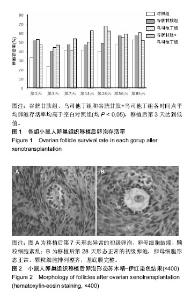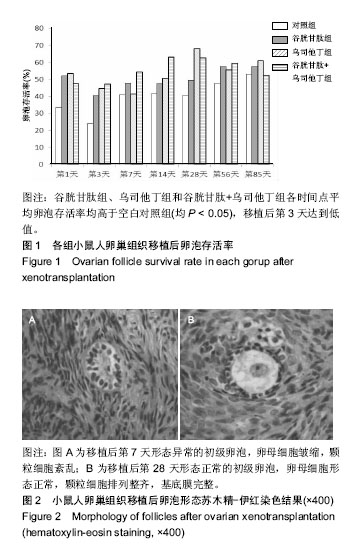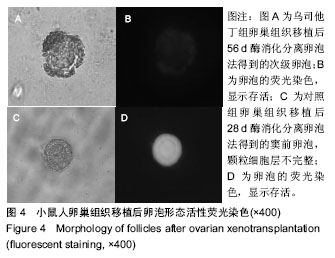Chinese Journal of Tissue Engineering Research ›› 2019, Vol. 23 ›› Issue (7): 1084-1089.doi: 10.3969/j.issn.2095-4344.1074
Previous Articles Next Articles
Protection of reduced glutathione and ulinastatin on frozen-thawed ovarian tissues after xenotransplantation
Long Huidong1,2, Long Lingli1, Mai Qingyun1, Zhao Wen1, Li Yubin1
- (1Center for Reproductive Medicine, the First Affiliated Hospital, Sun Yat-sen University, Guangzhou 510080, Guangdong Province, China; 2Shenzhen IVF Gynaecological Hospital, Shenzhen 518000, Guangdong Province, China)
-
Received:2018-10-29Online:2019-03-08Published:2019-03-08 -
Contact:Li Yubin, MD, Associate chief physician, Center for Reproductive Medicine, the First Affiliated Hospital, Sun Yat-sen University, Guangzhou 510080, Guangdong Province, China -
About author:Long Huidong, Master, Attending physician, Center for Reproductive Medicine, the First Affiliated Hospital, Sun Yat-sen University, Guangzhou 510080, Guangdong Province, China; Shenzhen IVF Gynaecological Hospital, Shenzhen 518000, Guangdong Province, China -
Supported by:the National Natural Science Foundation for the Youth of China, No. 81100470 (to LYB); the Natural Science Foundation of Guangdong Province, No. 2014A030313182 (to LYB); the Economic and Technological Development Project of Longgang District in Shenzhen, No. 20160606092142616 (to LHD)
CLC Number:
Cite this article
Long Huidong, Long Lingli, Mai Qingyun, Zhao Wen, Li Yubin. Protection of reduced glutathione and ulinastatin on frozen-thawed ovarian tissues after xenotransplantation[J]. Chinese Journal of Tissue Engineering Research, 2019, 23(7): 1084-1089.
share this article
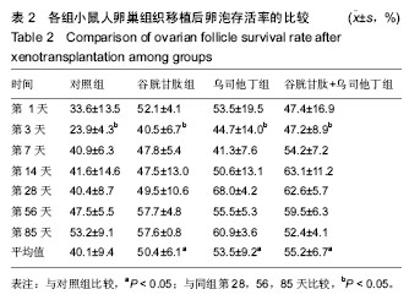
2.1 在NOD-SCID小鼠中的卵巢组织移植物回收 购买NOD-SCID实验小鼠96只,实验期间死亡12只,小鼠死亡率12.5%(12/96),死亡时间多在移植后56-85 d。卵巢组织移植物与小鼠组织分界清晰,容易辨认,移植后期偶有发现小鼠皮下缺失少量移植组织块,移植物回收率(回收的组织块/原移植的组织块)为99% (499/504)。 2.2 卵泡组织学及生长分析 共有84组蜡块行组织学切片检查,解冻后的卵巢组织中主要以始基卵泡为主;解冻后卵巢组织的卵泡存活率为(84.4±5.7)%。解冻后卵巢组织中的始基卵泡比例为(79.5±14.3)%,初级卵泡比例为(17.8±10.5)%,次级卵泡比例为(2.7±4.3)%,窦前卵泡比例为0。卵泡存活率见表2,图1;存活卵泡与不存活卵泡的形态苏木精-伊红染色结果见图2。"

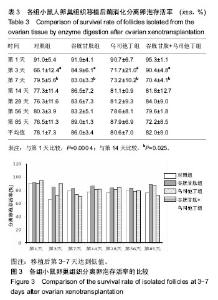
表2及趋势图显示,谷胱甘肽组、乌司他丁组及谷胱甘肽+乌司他丁组卵泡存活率均高于对照组(P=0.022);谷胱甘肽组、乌司他丁组和谷胱甘肽+乌司他丁组各时间点平均卵泡存活率均高于对照组,差异均有显著性意义(P < 0.05),联合用药组与单独用药比较差异无显著性意义(P > 0.05)。移植后各时间点之间的卵泡存活率有统计学差异(P=0.018),在移植后第3天达到低值(与第28,56,85天比较,P < 0.05),移植1周后有所上升(与第14天比较,P=0.38)。 2.3 酶消化分离卵泡 共有84组卵巢移植物进行酶消化的卵泡分离,每组用于消化的卵巢组织片为2-4块,消化 1 h后可在40×镜下找到不同阶段的卵泡,其中发现部分形态上类似卵泡的类圆形结构,但缺乏卵泡独有的层次结构及折光性,故排除在统计的范围之外。大部分卵泡已经游离,有部分密集的始基卵泡未游离,尝试用1 mL注射器针头机械分离,但是发现容易损伤或丢失卵泡,故将整个包含未游离卵泡的组织进行荧光染色,并测量卵泡直径。 2.4 分离卵泡的存活率结果 酶消化分离的卵泡行活性荧光染色后在荧光显微镜下观察,根据荧光的颜色直接评估卵泡存活,移植后卵巢组织分离卵泡的存活情况见表3,图3。"
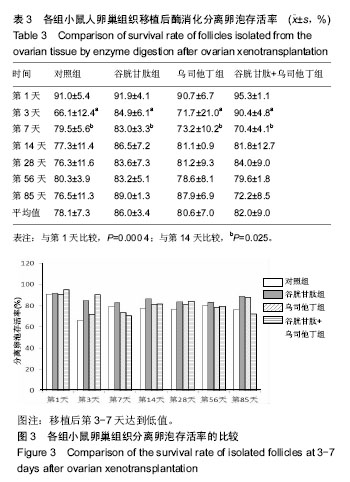
| [1] Lobo RA. Potential options for preservation of fertility in women. N Engl J Med.2005;(1):64-73.[2] Lotz L, Maktabi A, Hoffmann I, et al. Ovarian tissue cryopreservation and retransplantation-what do patients think about it? Reproductive BioMedicine Online. 2016;(4):394-400.[3] Huser M, Crha I, Hudecek R, et al. Ovarian tissue cryopreservation- new opportunity to preserve fertility in female cancer patients. Eur J Gynaecol Oncol. 2007;28(4):249-55.[4] Donnez J, Dolmans Mm Fau - Martinez-Madrid B, Martinez-Madrid B, et al. The role of cryopreservation for women prior to treatment of malignancy. Curr Opin Obstet Gynecol.2005;(4):333-338.[5] Donnez J, Dolmans MM, Demylle D, et al. Livebirth after orthotopic transplantation of cryopreserved ovarian tissue. Lancet. 2004; 364(9443):1405-1410.[6] Meirow D, Levron J, Eldar-Geva T, et al. Pregnancy after transplantation of cryopreserved ovarian tissue in a patient with ovarian failure after chemotherapy. N Engl J Med.2005; (3):318-321.[7] Ladanyi C, Mor A, Christianson MS, et al. Recent advances in the field of ovarian tissue cryopreservation and opportunities for research. J Assist Reprod Genet .2017;(6):709-722.[8] Li YB, Zhou CQ, Yang GF, et al.Modified vitrification method for cryopreservation of human ovarian tissues. Chin Med J (Engl). 2007;120(2):110-114.[9] Jensen AK, Macklon KT, Fedder J, et al. 86 successful births and 9 ongoing pregnancies worldwide in women transplanted with frozen-thawed ovarian tissue: focus on birth and perinatal outcome in 40 of these children. J Assist Reprod Genet.2017;(3):325-336. [10] Beckmann MW, Dittrich R, Lotz L, et al. Fertility protection: complications of surgery and results of removal and transplantation of ovarian tissue. Reprod Biomed Online. 2018;36(2):188-196.[11] Kim S, Lee Y, Lee S, Kim T. Ovarian tissue cryopreservation and transplantation in patients with cancer. Obstet Gynecol Science. 2018;(4):431-442.[12] Kristensen SG, Andersen CY. Cryopreservation of Ovarian Tissue: Opportunities Beyond Fertility Preservation and a Positive View Into the Future. Front Endocrinol (Lausanne). 2018;9:347.[13] Estrada E, Rodríguez-Gil JE, Rivera Del Álamo MM,et al.Effects of reduced glutathione on acrosin activity in frozen-thawed boar spermatozoa.Reprod Fertil Dev. 2017;(2):283-293.[14] Tao Z, Hu FQ, Li CF, et al.Effect of ulinastatin, a human urinary protease inhibitor, on heatstroke-induced apoptosis and inflammatory responses in rats.Exp Ther Med. 2017;(1):335-341.[15] Cho YS, Shin MS, Ko IG, et al. Ulinastatin inhibits cerebral ischemia-induced apoptosis in the hippocampus of gerbils. Mol Med Rep. 2015;12(2):1796-802.[16] Zhou L, Rui JA, Zhou RL,et al. Liver injury after intermittent or continuous hepatic pedicle clamping and its protection by reduced glutathione. Hepatobiliary Pancreat Dis Int. 2004;3(2):209-213.[17] Guan L, Liu H, Fu P, et al.The Protective Effects of Trypsin Inhibitor on Hepatic Ischemia-Reperfusion Injury and Liver Graft Survival. Oxid Med Cell Longev. 2016;2016:1429835.[18] Dolmans MM, Michaux N,Fau - Camboni A, et al. Evaluation of Liberase, a purified enzyme blend, for the isolation of human primordial and primary ovarian follicles. Hum Reprod.2006; (2): 413-420.[19] Martinez-Madrid B, Dolmans MM, Langendonckt AV,et al. Ficoll density gradient method for recovery of isolated human ovarian primordial follicles. Fertil Steril.2004;(6):1648-1653.[20] Dolmans MM, Michaux N, Camboni A, et al. Evaluation of Liberase, a purified enzyme blend, for the isolation of human primordial and primary ovarian follicles. Hum Reprod. 2006;21(2): 413-420.[21] Gougeon A. Dynamics of follicular growth in the human: a model from preliminary results. Hum Reprod. 1986;1:81-87[22] Candy CJ, Wood MJ, Whittingham DG. Effect of cryoprotectants on the survival of follicles in frozen mouse ovaries. J Reprod Fertil.1997; 110(1):11-19.[23] Israely T, Dafni H,Fau - Nevo N, et al. Angiogenesis in ectopic ovarian xenotransplantation: multiparameter characterization of the neovasculature by dynamic contrast-enhanced MRI. Magn Reson Med.2004; (4):741-750.[24] Kim SS, Yang Hw,Fau - Kang HG, et al. Quantitative assessment of ischemic tissue damage in ovarian cortical tissue with or without antioxidant (ascorbic acid) treatment. Fertil Steril.2004;(3):679-685.[25] Hreinsson J, Zhang P,Fau - Swahn ML, et al. Cryopreservation of follicles in human ovarian cortical tissue. Comparison of serum and human serum albumin in the cryoprotectant solutions. Hum Reprod. 2003; (11):2420-2428.[26] 焦桂萍,赵兵,袁志柳,等.还原型谷胱甘肽对大鼠肺缺血再灌注损伤的保护作用[J].中国临床保健杂志,2006,9(2):142-144.[27] Kevelaitis E, Nyborg NC, Menasché P.Protective effect of reduced glutathione on endothelial function of coronary arteries subjected to prolonged cold storage. Transplantation.1997;64(4):660-663.[28] 大西冶夫.Ulinastatin. Biomedical Sciences.1984, 5(2):76-77.[29] 曾文红,白国强.乌司他丁研究进展[J].中华肝胆外科杂志,2001,7(1): 52-54.[30] Matsumi M, Mizobuchi S, Kaku R ,et al. Changes of urinary tripsin inhibitor in blood and urine, as well as serum cytokines in living related liver transplantation. Masui. 2003;52(3):251-256.[31] 马兴久,耿振宏,李德春.乌司他汀对肝脏缺血再灌注损伤的防护作用[J].医师进修杂志,2005,28(7):22-28.[32] 钱叶本,赵红川,熊奇如,等.乌司他丁在肝脏缺血再灌注损伤和肝脏再生中的作用[J].中华肝胆外科杂志,2001,11(7):701-2.[33] 于金贵,周广利,孟冬梅,等.乌司他丁对心脏直视患者体外循环期炎性细胞因子和自由基的影响[J].中华麻醉学杂志, 2001,21(12):724-26.[34] Zhang XQ, Sun JL, Chen YJ, et al. Amelioration of ischemia-reperfusion injury of transplanted small intestine by ulinastatin: effects on accumulation and adhesion of neutrophil. Transplant Proc. 2005;37(10):4464-4466.[35] Nugent D, Newton H Fau - Gallivan L, Gallivan L,et al. Protective effect of vitamin E on ischaemia-reperfusion injury in ovarian grafts. J Reprod Fertil.1998;(2):341-346.[36] Schnorr J, Oehninger S,Fau - Toner J, et al. Functional studies of subcutaneous ovarian transplants in non-human primates: steroidogenesis, endometrial development, ovulation, menstrual patterns and gamete morphology. Hum Reprod.2002;(3):612-619.[37] Gadea J, Gumbao D,Fau - Matas C, et al. Supplementation of the thawing media with reduced glutathione improves function and the in vitro fertilizing ability of boar spermatozoa after cryopreservation. J Androl.2005; (6):749-756.[38] Luo CQ, Long LL,Li XH, et al.Human ovarian tissue xenografted in asepticallywounded mice to conserve follicles.Int J Clin Exp Med.2017; (9):13482-13490.[39] Nisolle M, Casanas-Roux F,Fau - Qu J, et al. Histologic and ultrastructural evaluation of fresh and frozen-thawed human ovarian xenografts in nude mice. Fertil Steril.2000;(1):122-129. |
| [1] | Zhang Tongtong, Wang Zhonghua, Wen Jie, Song Yuxin, Liu Lin. Application of three-dimensional printing model in surgical resection and reconstruction of cervical tumor [J]. Chinese Journal of Tissue Engineering Research, 2021, 25(9): 1335-1339. |
| [2] | Li Shanshan, Guo Xiaoxiao, You Ran, Yang Xiufen, Zhao Lu, Chen Xi, Wang Yanling. Photoreceptor cell replacement therapy for retinal degeneration diseases [J]. Chinese Journal of Tissue Engineering Research, 2021, 25(7): 1116-1121. |
| [3] | Zeng Yanhua, Hao Yanlei. In vitro culture and purification of Schwann cells: a systematic review [J]. Chinese Journal of Tissue Engineering Research, 2021, 25(7): 1135-1141. |
| [4] | Jiang Xin, Qiao Liangwei, Sun Dong, Li Ming, Fang Jun, Qu Qingshan. Expression of long chain non-coding RNA PGM5-AS1 in serum of renal transplant patients and its regulation of human glomerular endothelial cells [J]. Chinese Journal of Tissue Engineering Research, 2021, 25(5): 741-745. |
| [5] | Yang Xin, Jin Zhe, Feng Xu, Lu Bing. The current situation of knowledge and attitudes towards organ, eye tissue, body donation of residents in Shenyang [J]. Chinese Journal of Tissue Engineering Research, 2021, 25(5): 779-784. |
| [6] | Xu Dongzi, Zhang Ting, Ouyang Zhaolian. The global competitive situation of cardiac tissue engineering based on patent analysis [J]. Chinese Journal of Tissue Engineering Research, 2021, 25(5): 807-812. |
| [7] | Wu Zijian, Hu Zhaoduan, Xie Youqiong, Wang Feng, Li Jia, Li Bocun, Cai Guowei, Peng Rui. Three-dimensional printing technology and bone tissue engineering research: literature metrology and visual analysis of research hotspots [J]. Chinese Journal of Tissue Engineering Research, 2021, 25(4): 564-569. |
| [8] | Chang Wenliao, Zhao Jie, Sun Xiaoliang, Wang Kun, Wu Guofeng, Zhou Jian, Li Shuxiang, Sun Han. Material selection, theoretical design and biomimetic function of artificial periosteum [J]. Chinese Journal of Tissue Engineering Research, 2021, 25(4): 600-606. |
| [9] | Liu Fei, Cui Yutao, Liu He. Advantages and problems of local antibiotic delivery system in the treatment of osteomyelitis [J]. Chinese Journal of Tissue Engineering Research, 2021, 25(4): 614-620. |
| [10] | Li Xiaozhuang, Duan Hao, Wang Weizhou, Tang Zhihong, Wang Yanghao, He Fei. Application of bone tissue engineering materials in the treatment of bone defect diseases in vivo [J]. Chinese Journal of Tissue Engineering Research, 2021, 25(4): 626-631. |
| [11] | Zhang Zhenkun, Li Zhe, Li Ya, Wang Yingying, Wang Yaping, Zhou Xinkui, Ma Shanshan, Guan Fangxia. Application of alginate based hydrogels/dressings in wound healing: sustained, dynamic and sequential release [J]. Chinese Journal of Tissue Engineering Research, 2021, 25(4): 638-643. |
| [12] | Chen Jiana, Qiu Yanling, Nie Minhai, Liu Xuqian. Tissue engineering scaffolds in repairing oral and maxillofacial soft tissue defects [J]. Chinese Journal of Tissue Engineering Research, 2021, 25(4): 644-650. |
| [13] | Xu Huimin, Zhang Suping, Cao Weijie, Li Li, Zhang Ran, Wang Yiran, Wan Dingming. Human umbilical cord blood-derived mesenchymal stem cells in the treatment of refractory acute graft-versus-host disease: a single-arm clinical study [J]. Chinese Journal of Tissue Engineering Research, 2021, 25(31): 4921-4927. |
| [14] | Li Jun, Zuo Xinhui, Liu Xiaoyuan, Zhang Kai, Han Xiangzhen, He Huiyu, . Effect of over expression of miR-378a on osteogenic and vascular differentiation of bone marrow mesenchymal stem cell sheet [J]. Chinese Journal of Tissue Engineering Research, 2021, 25(31): 4939-4944. |
| [15] | Xing Hao, Zhang Yonghong, Wang Dong. Advantages and disadvantages of repairing large-segment bone defect [J]. Chinese Journal of Tissue Engineering Research, 2021, 25(3): 426-430. |
| Viewed | ||||||
|
Full text |
|
|||||
|
Abstract |
|
|||||
